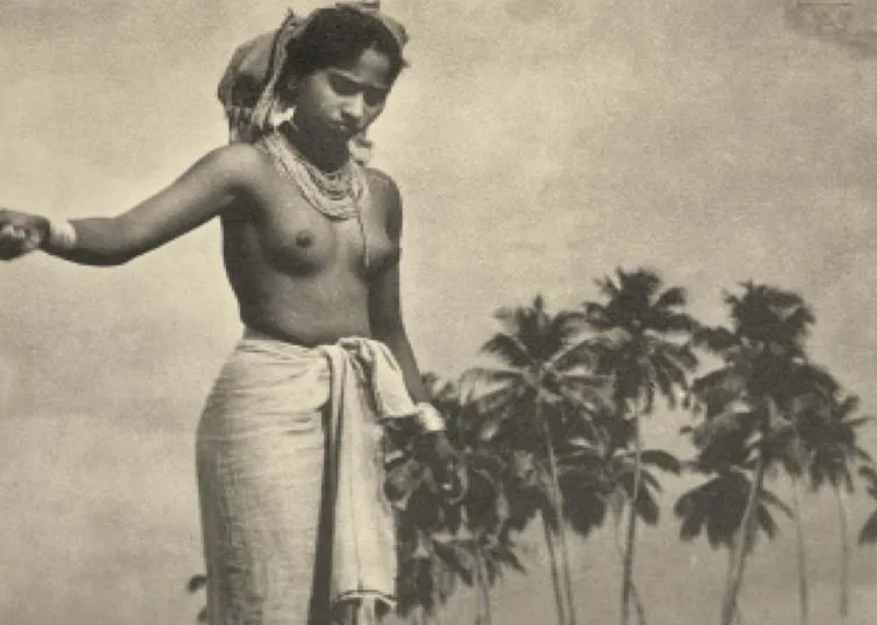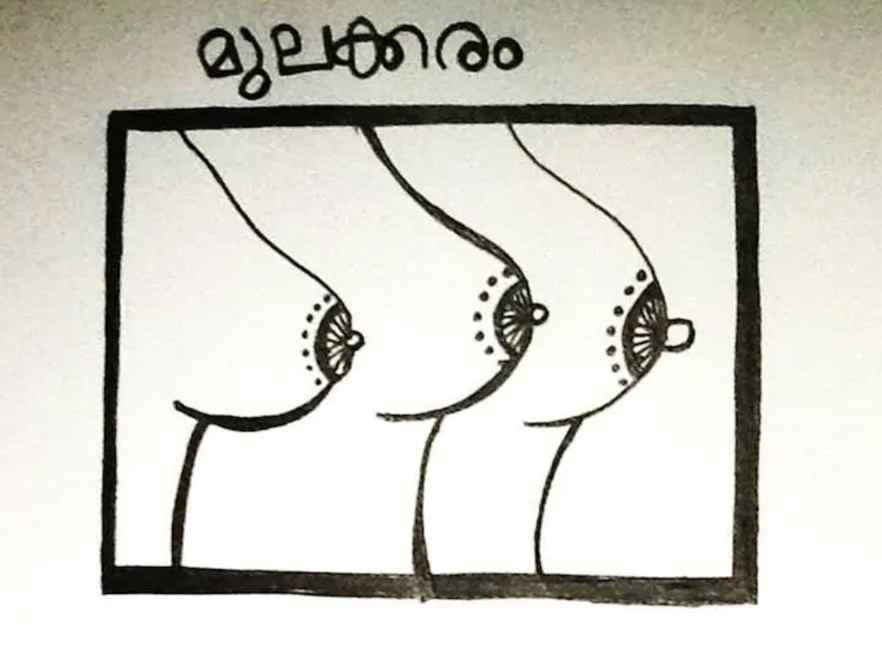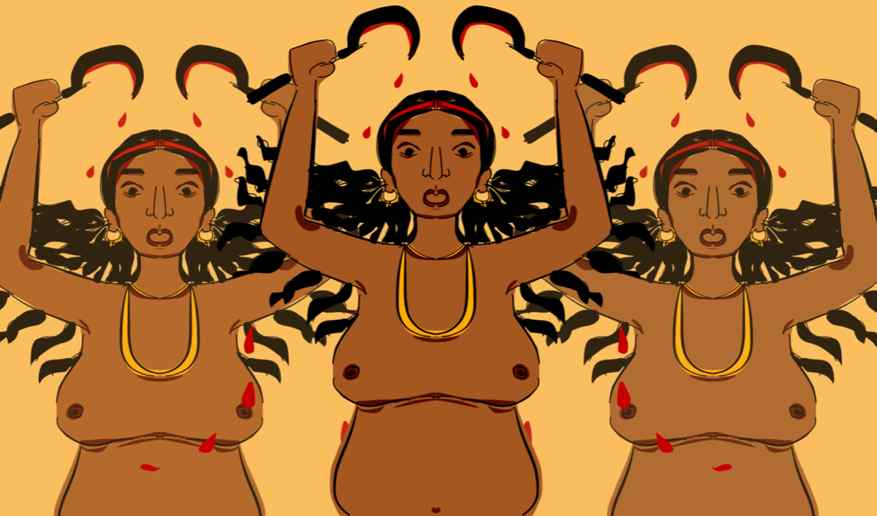- Umang Sagar
- History, Recent article
Mulakkaram (Breast Tax)

Preface To The South Indian Society
South India, often referred to as Dakshin Bharat, consists of the modern-day states of Karnataka, Kerala, Andhra Pradesh, and Tamil Nadu. Unlike North India, the South has remained quite distinct in its culture, language, and history.
South Indian kingdoms age way back to the times of the Pandavas, Cholas, and the Chalukya from 600BC to 300 CE and beyond.
What also distinguishes the South from the rest of the country, is that the South remained fairly free from Mughal rule and British rule. There were independent kingdoms, constituencies, and presidencies.
As we learn more about the rather odd but true breast tax, we must keep certain points on our mind while studying South India, and more particularly about Kerala and the presence of casteism.
Even though the South remained free from Mughal and British rule, there were important conquests that took place in the South. Vasco Da Gama arrived in Cochin (Kochi) in the 15th century and opened up the most revolutionary spice trade route and the first contact of India with Christianity.
Owing to the strategic location of the South, many people of different nationalities arrived and slowly got integrated into the society. There are Islamic, Christian, Syrian Christians, African, and other cultures found in the South even today.
South Indian Society has a Dravidian origin. Dravidians consider themselves as the descendants of the sun. There are almost 250 million Dravidian origin people at present. North Indian habitants are Aryans unlike in the South.
The influence of the Brahmin domination and influence reaches South pretty much after the North. Even though the South Indian people are religious, casteism was never too rigid until certain factors spearheaded its spread.
Status Of Women In South India

South Indian societies are matrilineal. It means women were in authority to take decisions and keep a tab of all the wealth and monetary affairs. The Nair or Nayyar caste of Kerala was considered to be the most influential Hindu group where women enjoyed supreme power and authority. After marriage, women went to live with their parents and their husbands came to visit them often.
All these customs were very unlike in the North; where there was a patriarchal system of society. Women were treated as second-class citizens. Evil social practices like Sati, child marriage, and the Devdasi system prevailed.
Even though South Indian women enjoyed a superior position, one cannot overlook the caste division that meted out discriminatory treatment to the lower caste people; especially women.
Breast Tax

In Kerala, it was considered a social norm that women of lower caste should bare their upper bodies in the presence of upper caste people as a sign of respect and homage to them. If they wished to cover their breasts, they had to pay a tax called the ‘Mulakkaram’. This tax was even measured based on the size and shape of the breasts. The lower castes were namely the Nadars and the Ezhavas. This tax was not done to robe the dignity of women, but rather to punctuate and differentiate women of lower caste from the upper.
Clothing and covering bodies were considered to be respectable and thus were considered more suitable for the upper caste. This also passively became a norm after the British colonized India and spread their cultural belief that Indian people do not wear clothes and are ‘savages’. The Thot tropical weather of India was not suitable to fully cover the upper bodies, men and women alike.
But with the rise of the oppressive caste rules in Kerala, the Brahmins began to project that upper caste women and men are only eligible to cover their bodies.
This tax came into effect when a girl hit 14 years of age and began working in the fields or as a laborer. They even had to step aside if an upper caste was approaching and wait for them to pass. This was considered a sign of modesty and humbleness before the upper caste people.
This tax was also purposely levied to keep the lower caste people economically burdened if they wished to cover themselves. They could hardly spare themselves proper meals and this tax was a burden that could be renewed with time. The Brahmins knew this well that greater economic capacity meant greater social power, so they kept the lower caste people debating and in a money-crunching situation.
Channar Revolt

The Channar Revolt or the Channar Lahala was a series of efforts and uprisings against the oppressive taxing system. It took place from 1813 to 1859 in the Travancore region of Kerala.
In 1813, the Travancore court ruled out an order that women converted to Christianity could cover their upper bodies with a single piece of cloth. This was met with fierce rejection by the Travancore ruler who wanted to maintain the level of the supremacy of the upper castes. The Royal Court of Travancore only allowed them to wear a jacket that was worn by the Syrian Christians. But the Nadar women wanted to wear sarees just like any other upper caste women and embrace Indian clothing.
This angered the royal court and forbade the women strictly. This led to a series of protests and the women burned down churches, schools, and buildings of importance. In 1829, the Travancore queen ruled another proclamation that again forbade women to wear clothes like an upper caste woman.
The story of Nangeli morally inspired many women and even compelled the Travancore administration to call off the tax. Nangeli was a lower caste woman of the Ezhava caste and worked as a toddy maker. The tax collection officers were to visit her and collect the tax. Nangeli, being disgusted with the discriminatory tax, chopped off her breast and presented it to the officers on a plantain leaf. She succumbed soon to her injuries and the officers were shocked. His husband could not watch the sight in order and threw himself to death on her funeral pyre.
This one single act of sacrifice compelled the authorities to call off the tax and issued a decree that allowed lower caste women to cover their breasts like that of an upper caste woman.
Effects Of Casteism
While the upper caste people thought they would be able to retain their control forever, it was not the case.
Deep casteism in Kerala resulted in actions, which are as follows:-
With the influx of Syrian Christians in South India, lower-caste women converted to other religions to gain social mobility and respect. They found respect and dignity in a new religion. The Brahmins felt their religion was in danger.
Another popular social phenomenon was called Sankristization or Brahminization. This social act consisted of the lower caste acting like the Brahmins to gain mobility in the social hierarchy. They gave up meat and liquor in the hope of gaining the respect of that of a Brahmin.
Effects Of Colonialism On The Indian Society
Another perspective can be viewed in this context. When the British invaded India and started to reach out to all the parts of the country, women especially higher caste women started to guard themselves against the ‘Western’ male gaze. The Indian men wanted to protect their women from ‘firangi’ men and the women started to cover their upper bodies. The hot Indian weather meant women never really covered themselves until foreigners started to arrive.
Especially women in South India use to wear a simple drape on their lower body parts and adorned themselves with gold jewelry that regulated their body temperature. They always kept their upper bodies bare. This even applied to men and lower-caste women.
Sashi Tharoor, in his book, ‘Why Am I a Hindu’ highlights that the strict regulation that we see in today’s Hinduism resulted from the need to guard the people against the British people. Social practices like Sati and not allowing widows to remarry were done to protect Indian women from marrying British males.
So this gives us an idea that it was only in the late 19th Century that upper-caste women started covering themselves and lower-caste women were not given the preference to guard themselves.
The Ambiguity Of The Breast Tax
There are many counter-theories and stories as well against this social norm.
Historian and author Manu S. Pillai argue that the concept of the breast tax is not as it is projected. Covering the upper parts of women’s bodies was never the norm until the Victorian idea of modesty reached India through colonialism. He says that even the upper caste women and the royal members did not cover their breasts until the 1860’s when the Victorian era was at its peak. It is even recorded in early history that upper-caste women met English officers without any covering.
Pillai says that this tax was done to differentiate the sexes and more specifically the patita jaati women. It was done to economically differentiate the group.
However, the act of Nangeli was an act of protest against the Brahmin practice of dominating the lower caste people in all aspects of their lives. Caste-based violence takes place even today. But there can be a very thin line between covering the upper body for modesty and baring them all in lieu of Indian culture.
Conclusion
Many social practices in India have multiple perspectives and narratives. The real question that remains even today is whether women have autonomy over their own bodies.
Even though this practice of breast tax was legitimized to a certain degree, it took one woman to chop off her breasts to protest this inhumane practice. Lower-caste women face caste-based violence even today.
The act of collecting tax to cover the breasts resulted in social changes too in Hindu society, especially in South India. There was an amalgamation of English values and the uplift of women to the lower castes that led to social changes for the better. Women started attaining education, wearing fully covered clothing, demanding better respect, and taking up conventional men’s jobs themselves.
Many historians say that fashion in Indian wear even began to change. Blouses became an integral part of womenswear. During the pre-Swadeshi period, there were only saree handlooms but soon after, blouse boutiques sprang up. In Bengal, puff-sleeved blouses with laces came up after being heavily influenced by Victorian sleeves.
Lower caste women from all over India could now demand better respect and position in society. They saw that the law and Brahmins controlling their bodies was a threat to their bodily autonomy. It was also a time when feminist values were gaining traction in the whole world and more and more women now started covering themselves to take up a serious role and action against the British government.
Many historians do not agree with the conventional representation of the breast tax but do agree with the caste treatment of women and other lower caste people. In South India too, casteism became deeply ingrained and more rigid in a rather matriarchal-style society. The Brahmins saw it as the only way to gain social control.
Top 13 Interesting Facts About Mulakkaram
Apart from the breast tax, there were many other types of tax as well that were imposed on the lower caste people to keep them economically burdened.
One of them was the tax given in order to organize a marriage in a way similar to that of a Brahmin.
The main motive of the breast tax was not to outrage the modesty of women but to keep the lower caste people economically subjugated.
In South Indian society, even though it was matriarchal in nature; the real decisions were taken by the brothers or fathers of the females.
It was only when the British printed out that uncovered breasts were not modest, the lower caste women started revolting against this practice. It was very much a regular custom that was widely accepted.
It was only seen in Kerala and the South because the dressing style was different from that of the north.
The Ruler of Travancore had also imposed other subjugation taxes like the moustache tax, head tax, and even taxes on the fisherman’s net.
The death of Nangeli also compelled the royal family of Travancore to call off the other taxes.
The Channar revolt was led by a prominent guru named Narayan Guru.
The Channar Revolt is also known as the Maru Marakkal Samaran.
The revolters placed their demands and grievances by getting orders from the British Court through the dewans.
The hierarchical system was based on several rankings. The Ezhavas ahead to bow down their head to the Nairs and the Nairs to the higher Nambudiri Brahmins.
The presence and influence of other communities in Kerala further led to the revolt and protest against this practice.



